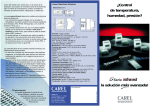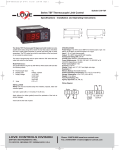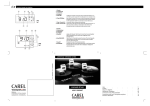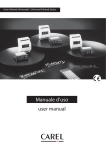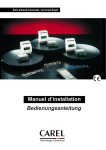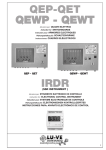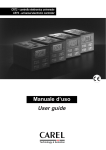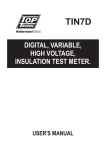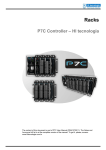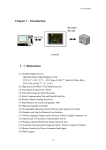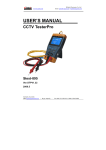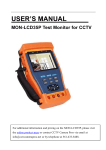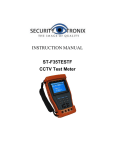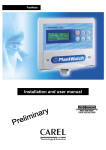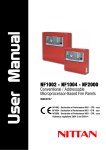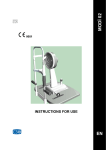Download +302237336 depl. INFRARED ing
Transcript
Dimensions (mm) reverse direct PRG mute SEL 75 The new Universal Infrared instruments feature exceptional characteristics: • each controller comes complete with nine different configured programs allowing you to set the regulation program suitable to your application easily and quickly (see inside page on this leaflet for further details); • the majority of Infrared controllers are powered with alternating or continuous 12/24 Volts. Additionally, there are 110/230 Vac-dc models; • all Infrared models come complete with 1 or 2 digital inputs permitting straightforward alarm management (even delayed alarms), set-point variation (via outside clock or switch), remote ON-OFF, Cooling/Heating switching, etc; • all thermostats equipped with NTC sensor (thermistor) can be connected to a second sensor to make your instrument perform additional special functions. 64 71.5 1 2 3 4 direct reverse SEL PRG 87 44 mute 88 The new Infrared Range comprises a series of different models capable of satisfying the most demanding application requirements: • our instruments can be connected to the most common temperature, humidity and pressure sensors available on the market (NTC, Pt100, thermocouples type J or K, 0-20mA, 4-20mA, 0-1Vdc); • the controllers are available with one, two, and now also with four outputs, both in the 8A resistive changeover relay versions and in the 10Vdc output versions operating external Solid State Relays; • you can choose between two different case models: panel-mounted with front panel protection index IP65 and DIN-rail mounted models. Temperature, humidity, pressure control? TECHNICAL SPECIFICATIONS 33 Carel, leader in the production of controllers for more than twenty years, is proud to introduce a new series of innovative instruments specifically designed for the control of temperature, pressure, humidity in Air-Conditioning, Refrigeration and Heating systems. 5 6 7 8 70 11 59.1 36 60 Inputs: depending on the model Temperature: NTC, Pt100, thermocouples K/J Current: 4/20 mA or 0/20 mA – voltage: -0.5/1 Vdc Operating range: NTC: -50÷90°C, Pt100: -100÷600°C, TcK: -100÷999°C, TcJ: -100÷800°C Current and voltage: -99/999 Resolution: 0.1 from -9.9 to 99.9 – 1 for different ranges Precision: ± 0.5% of the range Power supply: Voltage: IR32V, D, W, Z, A: 12/24 Vac-dc ±10% IRDRV, W: 24 Vac ±10% and 220/240Vac ±10% IRDRTE: 220/240Vac ±10% – IRDRZ and IRDRA: 12/24 Vac-dc, ±10% Absorbed power: IR32V: 2 VA – IR32W, Z: 3 VA IRDRTE, IRDRV, IRDRW: 3 VA – IRDRZ: 4 VA Operating temperature: 0÷50°C Storage temperature: -10÷70°C Ambient relative humidity: below 90% rH, non condensing Ambient pollution: normal Relay characteristics (all models): max. voltage 250Vac, max. power 2000VA – max. initial current 10A Signal features for Solid State Relay: Output voltage: 10Vdc Output res.: 660Ω Max. output current: 15mA Disconnection: type 1C according to ECC EN 60730-1 standards Case: plastic, IR32 self-extinguishing standards according to UL94-VO Series the most advanced solution! agency/distributor: The Infrared Range can be programmed in three ways: using the keypad of the instrument itself, your Personal Computer or a dedicated exclusive remote control. CAREL srl Via dell’Industria, 11 - 35020 Brugine - Padova (Italy) Tel. (+39) 049.9716611 Fax (+39) 049.9716600 http://www.carel.com +302237336 rel. 2.0 del 10/02/99 Remote Control Unit Advanced programming and supervision systems In order to program your Infrared instruments, Carel has designed Modì, a software specifically created to set any working parameter easily via PC. Any standard configuration filed in your PC can be easily and quickly transmitted to the Infrared controllers via serial line, thus avoiding any possible error that might occur when programming them manually. An incredible advantage, especially when you need to program many controllers simultaneously. As for supervision and telemaintenance services, Carel has designed MasterPlant, the program running under Windows™ permitting supervision, monitoring and telemaintenance of refrigeration and air-conditioning plants equipped with Carel controllers. MasterPlant allows you to manage up to 800 instruments connected to a local and/or remote PC via Modem. Among its numerous functions, MasterPlant allows you to: centralize on just one local and/or remote PC all the operating parameters of showcases, display cabinets, walk-in refrigerators, chillers, roof-top units, humidifiers, etc; check all the operating parameters of the system via telephone line and keep them under control on your PC, via modem; in this way you will be able to control several plants located in different geographical areas from a central station; be informed immediately and automatically of any alarm, via modem or fax. In the event of off-normal condition, a fax can be sent to different operators; file temperature, humidity, pressure values and possible alarms as established by EU standards; print graphs on customized forms. List of operating parameters Par. Description St1 St2 C0 Set Point 1 Set Point 2 Mode of Operation (see inside page) Selection of Differentials P1 Differential of Set Point 1 P2 Differential of Set Point 2 P3 Dead zone differential C4 Authority for Set Point offset C5 Type of control action (Proportional, P+I) Outputs C6 Time-delay between energization of 2 different relays C7 Min. time between energizations of the same relay C8 Min. disenergization time of the relay C9 Min. energization time of the relay C10 Relay status in the event of sensor alarm: 0 = all relays disenergized 1 = all relays energized 2 = Relays in Direct energized, disenergized the others 3 = Relays in Reverse energized, disenergized the others C11 Output rotation 0 = no rotation 1 = standard rotation 2 = rotation of capacity-controlled compressors 3 = as above with N.O. valves C12 Time interval in PWM mode Sensor C13 Type of sensor P14 Sensor calibration C15 Min. value for input I and V C16 Max. value for input I and V C17 Anti-noise filter C18 Temperature unit selection: 0=°C, 1=°F Optional Modules The IR32A, IR32D and IRDRA models, complete with voltage outputs for Solid State Relays, can be successfully used to manage complex systems equipped with several ON/OFF or Proportional devices. The Infrared Series, in fact, can be equipped with optional modules allowing instrument to convert the signal of the output into a proportional signal (0-10 Vdc or 4-20 mA) or an ON/OFF signal (10 A res. relay). Just one single IR32A or IRDRA can manage up to four optional modules! C19 Second sensor (models for NTC only) 1 = differential operating mode 2 = summer offset 3 = winter offset 4 = neutral-zone offset Set-Point C21 Min. value Set-point 1 C22 Max. value Set-point 1 C23 Min. value Set-point 2 C24 Max. value Set-point 2 Alarm parameters P25 Low temperature set-point alarm P26 High temperature set-point alarm P27 Alarm differential P28 Time-delay before alarm starts C29 Digital input 1 0 = idle input 1 = immediate external alarm, automatic reset 2 = immediate external alarm, manual reset 3 = delayed external alarm (P28) 4 = ON/OFF C30 Second digital input management C31 Output status in the event of alarm condition via digital input: same options as C10 Further settings C32 Serial connection address C50 Keypad (TS) and Remote Control (TC) management 0 = TS OFF, TC ON (type P parameters only) 1 = TS ON, TC ON (type P parameters only) 2 = TS OFF, TC OFF 3 = TS ON, TC OFF 4 = TS ON, TC ON (any parameter) C51 Code to activate the remote control unit Modes of operation Setting parameters is a really simple operation as each Infrared instrument comes complete with nine factory-set modes of operation to suit any application requirement. In order to select one of the nine Modes, all you have to do is just set only one parameter: the controller will automatically load all the values associated to the chosen Mode. 6) DIRECT/REVERSE switching via digital input. Applications: Air-Conditioning units, especially those having a cooling/heating operating mode (heat pumps, fan coils, etc.). The instrument works with two different parameter lists (set-point and differential), one for cooling, the other for heating. Switching the working mode and the working set-point is a completely automatic operation (via digital input through a switch or a clock). mod. V OUT 1 OUT 2 OUT 1 OUT 2 D D D D D Diff.(P1) For further information see the descriptions below. OUT 3 D OUT 4 D Diff.(P1) Diff.(P1) Set (St 1) For more experienced operators a tenth mode of operation is also available so as to combine the nine modes with further functions of the Infrared Series and get new algorithms. For more information ask for the Infrared Series User Manual (code +030220160) your distributor or Carel (fax: +39 49.9716600). mod. Z mod. W OUT 1 Set (St 1) Set (St 1) DIGITAL INPUT OPENED mod. V mod. Z mod. W OUT 1 OUT 2 OUT 1 OUT 4 OUT 3 R R R R R Diff.(P2) OUT 2 R OUT 1 R Diff.(P2) Diff.(P2) Set (St 2) Set (St 2) Set (St 2) DIGITAL INPUT CLOSED 1) DIRECT mode of operation. Applications: Refrigeration and Air-Conditioning sectors (control of chillers, compressor packs, etc.). When the controlled parameter increases, the instrument actuates a control sequence so as to reduce its value and reach the set-point (desired performance). mod. V mod. Z mod. W OUT 1 OUT 1 OUT 2 OUT 1 OUT 2 D D D D D Diff.(P1) D OUT 4 D Diff.(P1) Diff.(P1) Set (St 1) OUT 3 7 and 8) DIRECT/REVERSE mode of operation with set-point and differential change via digital input. These modes of operation are similar to modes 1 and 2. Modes 7 and 8 allow your instrument to work with two different set-points and differentials so as to modify operation during the day and the night, or more generally, to optimize energy requirements. The parameters are modified via digital input through a switch or an external clock. The type of control action – Direct in mode 7 (showed in the figure below) and Reverse in mode 8 – does not change. Particularly useful for chillers, condensation units, etc. Set (St 1) Set (St 1) mod. V 2) REVERSE mode of operation. Applications: Heating and Air-Conditioning sectors (control of heaters, heat pumps, etc.). When the controlled parameter decreases, the instrument actuates a control sequence so as to increase the value of the parameter up to the set-point. OUT 1 OUT 2 OUT 1 OUT 2 D D D D D Diff.(P1) Set (St 1) mod. W OUT 2 OUT 1 R mod. Z OUT 1 R OUT 4 R Diff.(P1) OUT 2 OUT 3 R R R Diff.(P1) D Set (St 1) Set (St 1) DIGITAL INPUT OPENED mod. Z mod. W OUT 1 OUT 2 OUT 1 OUT 2 OUT 1 D D D D D R Diff.(P2) Set (St 2) Set (St 1) OUT 3 OUT 4 D D Diff.(P2) Diff.(P2) Set (St 2) Set (St 2) DIGITAL INPUT CLOSED 3 and 4) DEAD ZONE mode of operation. Applications: Air-Conditioning, seasoning, etc. The controller responds to any deviation from the set-point, forcing the value of the controlled parameter within a specific range (dead zone). In the PWM mode (mode 4) the time necessary for the outputs to energize depends on the deviation from the set-point. In this case we suggest using models 'A' and 'D' for Solid State Relays. 9) 2 SET-POINTS mode, one in Direct, the other in Reverse. This mode of operation is available only in 2-output (W) or 4-Output (Z/A) models. Half of the outputs energize in the Direct mode, the other half in the Reverse. The two set-points are independent. This mode of operation allows you to control your equipment as if you had two different instruments connected to the same sensor. mod. W OUT 1 mod. V mod. W OUT 1 R Diff.(P1) (P3) (P3) D Diff.(P1) D R (P3) OUT 2 R OUT 2 OUT 1 Diff.(P1) OUT 4 Diff.(P1) OUT 1 Diff.(P1) Set (St 1) Set (St 1) OUT 3 D Diff.(P1) mod. V mod. V mod. Z mod. W OUT 1 Diff.(P2) Set (St 2) Set (St 1) Diff.(P2) Neutral zone mod. Z Neutral zone Set (St 1) Set (St 1) OUT 2 OUT 1 OUT 3 OUT 4 R R D D mod. Z OUT 2 OUT 3 OUT 1 R OUT 4 D R (P3) Diff.(P1) (P3) Diff.(P2) Set (St 2) Diff.(P1) Set (St 1) D Diff.(P2) Set (St 1) Neutral zone Set (St 1) Wiring diagrams. The wiring diagram below as example refers to the IR32Z model for NTC, PT100, TC J/K or V/I probes. Important: each instrument should be connected to a specific sensor. For further details contact your nearest agent. OUT 3 5) ALARM mode of operation. This mode of operation allows you to get a complete alarm management. In 4-output models, for example, two outputs can be used to make the instrument perform control action within the dead zone and the other two can be used to manage high and low (temperature) alarms. mod. V 1 (P3) Diff.(P27) Neutral zone High/Low Alarm Diff.(P1) Diff.(P27) (P25/P26) Set (St 1) (P25/P26) OUT 1 Diff.(P27) Diff.(P1) 1 OUT 2 4 (P3) Diff.(P2) Low Alarm Neutral zone Set (St 1) 6 7 8 9 COM DIG.IN 3 4 - + 12-24 V 3 VA Diff.(P27) 1 7 (P25) 5 5 6 7 8 9 OUT 4 D R DIG.IN COM NTC1 NTC2 _ 12-24 V ~ 3 VA POWER 2 OUT 1 (P3) 3 c mod. Z OUT 3 2 OUT 1 R High/Low Alarm POWER SERIAL LINK c c c OUT 2 OUT 1 13 14 15 16 17 18 c mod. W OUT 1 OUT 4 OUT 2 10 11 12 High Alarm (P26) 2 8 3 9 Pt100 7 _ 8 9 TcJ/K + 7 M 8 9 +10 V/I OUT



